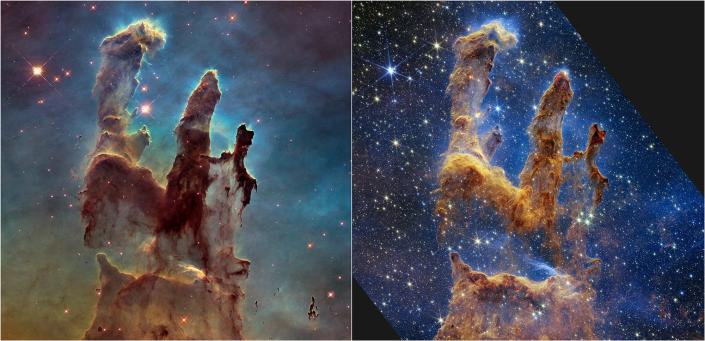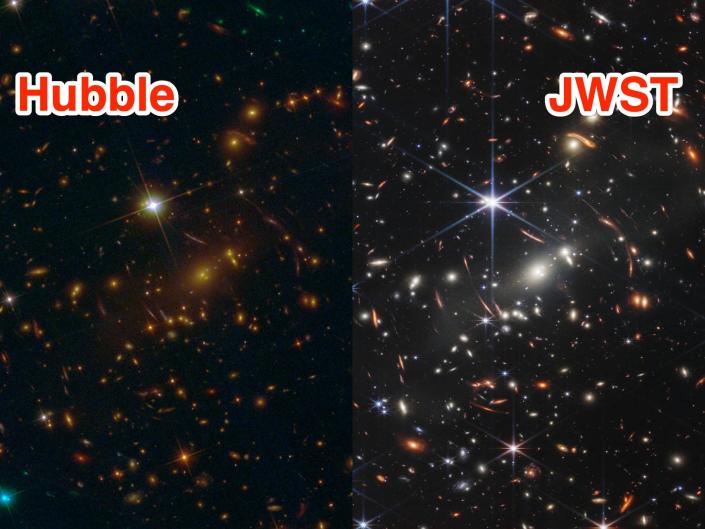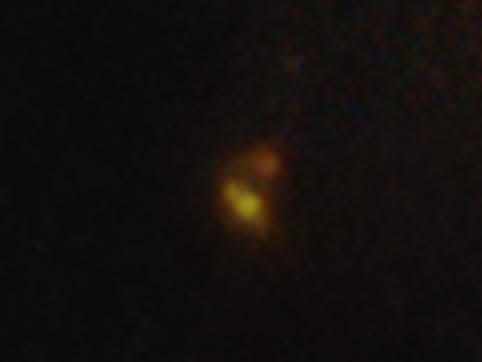The James Webb Space Telescope can capture a more complete view of galaxies, stars, and planets.
The powerful telescope is 100 times stronger than its predecessor, Hubble, and uses infrared light.
JWST began science operations in July. Scientists stress it’s just beginning to unveil the universe.
NASA’s James Webb Space Telescope has been delivering mind-blowing views of the cosmos since it began science operations in the summer.
Before Webb, astronomers had another workhorse cosmic observatory: the Hubble Space Telescope. Both are space-based telescopes, but they differ in many ways. Hubble sees ultraviolet light, visible light, and a small slice of infrared, while Webb looks at the universe across the infrared spectrum.
Webb is 100 times stronger than Hubble, which allows astronomers to peer even further into space. As its first few months of observations have proved, Webb is capable of taking the most striking shots yet of the universe.
Webb provided sharp views of Jupiter’s auroras and storms that Hubble can’t see

In August, Webb snapped images of Jupiter — the largest planet in our solar system. When compared to Hubble’s images of the gas giant, above on the left, Webb offers a sharper and crisper image, and showcases new details of Jupiter’s auroras and storm systems.
In Webb’s image of Jupiter, above on the right, the planet’s Great Red Spot — an enormous storm that has been swirling for centuries — is so bright with reflected sunlight that it appears white.
Webb’s infrared image also shows Jupiter’s auroras lighting up both the planet’s poles. Auroras are colorful displays of light that are not unique to Earth. Jupiter has the most powerful auroras in the solar system, according to NASA.
On both Earth and Jupiter, auroras occur when charged particles from the sun interact with the magnetic field — known as the magnetosphere — that surrounds a planet. Jupiter’s magnetic field is about 20,000 times stronger than Earth’s.
Webb revealed thread-like filaments in the Orion Nebula hidden to Hubble

NASA released images of the Orion Nebula — a massive star-forming region 1,350 light-years from Earth — that Webb took in September. The nebula is the nearest stellar nursery to us.
Dense clouds of cosmic dust in the nebula obscure star-forming structures from instruments that rely on visible light, like in Hubble’s image of the nebula, above to the left. By gathering infrared light, Webb is able to peer through those layers of dust, giving astronomers unprecedented views of the nebula’s various components.
Astronomers believe nebulae are clouds dominated by vast, tangled, thread-like structures, called filaments, which feed material like gas to form and fuel stars. Webb’s images reveal these gaseous threads in great detail.
Webb revealed hundreds of stars Hubble couldn’t see in the epic Pillars of Creation

In October, NASA released a snapshot Webb took of the Pillars of Creation — towering columns of gas and dust where stars are born. The epic stellar nursery is within the vast Eagle Nebula, a cloud of dust and gas 6,500 light-years away.
Hubble also imaged the famous nursery in 1995, above to the left. When comparing the two images next to one another, Webb’s camera pierces through solid columns of cosmic dust, revealing hundreds of stars that Hubble couldn’t see.
Webb spied countless galaxies that Hubble missed

One of the first images that NASA shared from Webb was a “deep field” image — a long-exposure observation of a region of the sky, which allows the telescope to capture the light of extremely faint, distant objects. The image took less than a day to capture, according to NASA.
When unveiling the image in July, NASA Administrator Bill Nelson said that if you held a grain of sand at arm’s length, that would represent the speck of universe you see in this image.
“The deep field image fills me with wonder and hope,” Lisa Kaltenegger, professor of astronomy at Cornell University and director of the Carl Sagan Institute, previously told Insider.
A side-by-side of Hubble’s deep field next to Webb’s reveals just how much sharper and stronger the new space observatory is.
Webb revealed 2 stars inside this nebula, where Hubble only saw one

This is the Southern Ring Nebula, where a dying star is slowly expelling the layers of its atmosphere in successive waves, creating ever-expanding bubbles of colorful gas. Scientists knew there were two stars at the nebula’s center, but couldn’t see them in Hubble’s images.
The new Webb picture reveals the dying star, which glows red because it’s surrounded by dust, right next to its white companion star.
An iconic cluster of 5 galaxies is much brighter and clearer in Webb’s eye

Four of the galaxies in this image of Stephan’s Quintet are about 300,000 light-years away, locked in a cosmic dance as each galaxy’s gravity influences the others.
The Webb image also reveals new galaxies far in the background, which weren’t visible to Hubble.
Where Hubble saw a faint dot, Webb resolved 2 distinct mystery objects

Dan Coe, a researcher with the Space Telescope Science Institute, first discovered this object in deep space about 10 years ago, using Hubble.
“With Hubble, it was just this pale, red dot. We could tell it was really small, just a tiny galaxy in the first 400 million years of the universe. Now we look with Webb, and we’re able to resolve TWO objects,” Coe said in an October NASA release.

Both Hubble and Webb study the early universe through gravitational lensing. That’s what happens when a cluster of distant galaxies is so massive that it warps space-time, bending the light from galaxies far in the distance behind it. That creates mirror images of those galaxies, reflected back at us.
So the imprint of the mystery objects appears in three spots in the images above. Breakouts of those three images of the system, on the right, show how much clearer Webb’s images are. They clearly show two different objects.
“We’re actively discussing whether these are two galaxies or two clumps of stars within a galaxy,” Coe said in the release. “We don’t know, but these are the questions that Webb is designed to help us answer.”
Read the original article on Business Insider